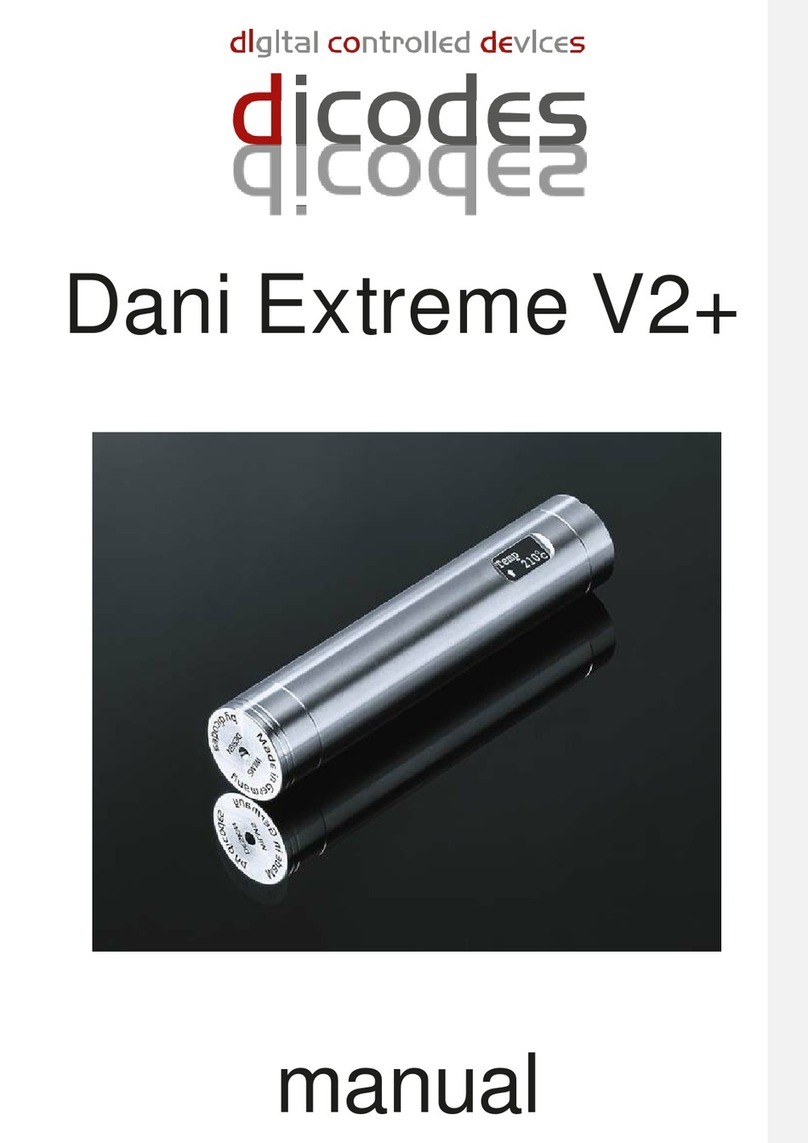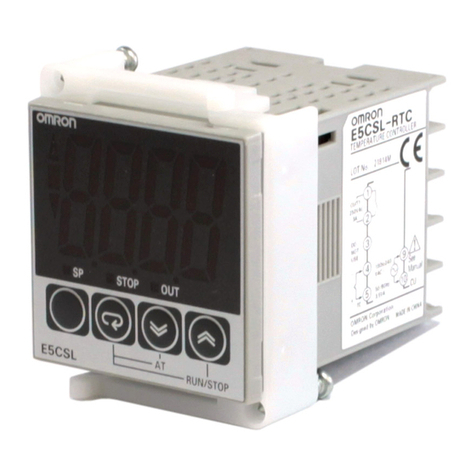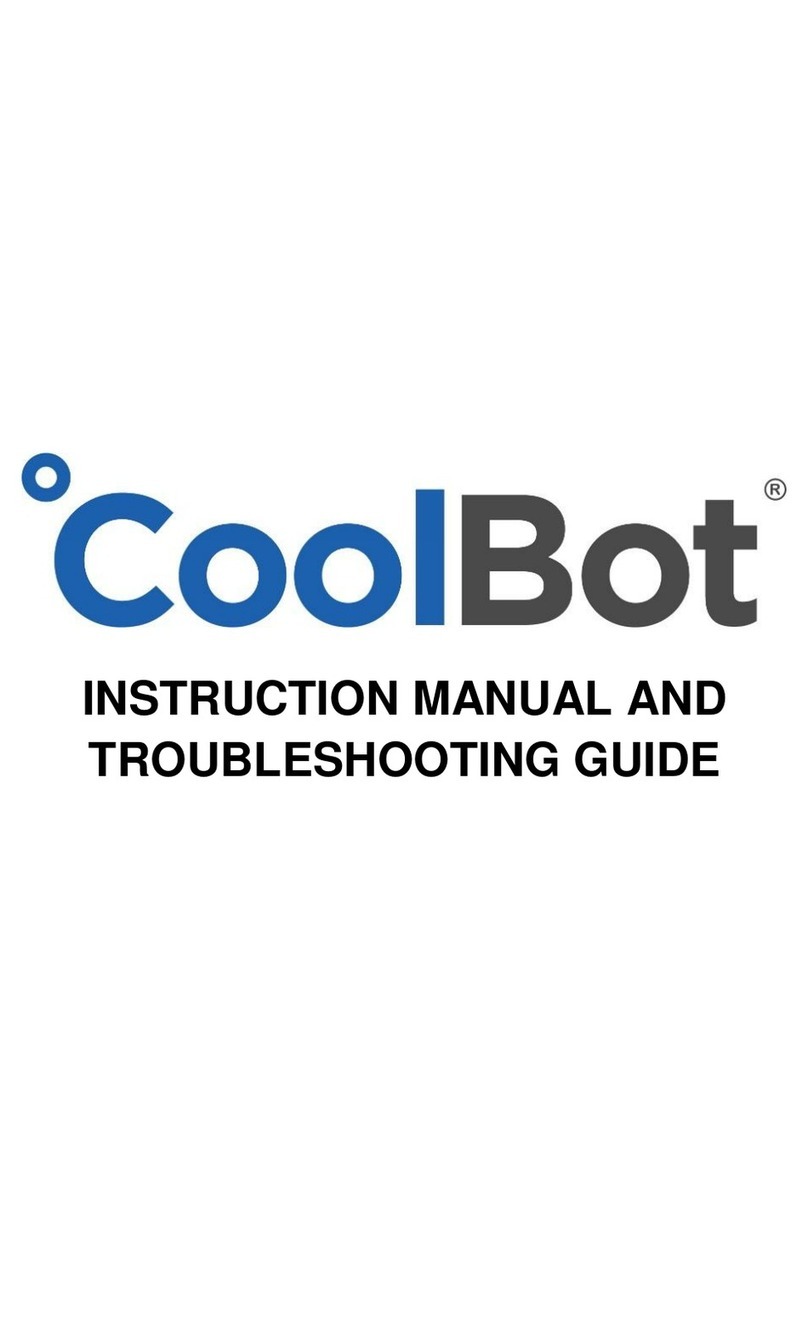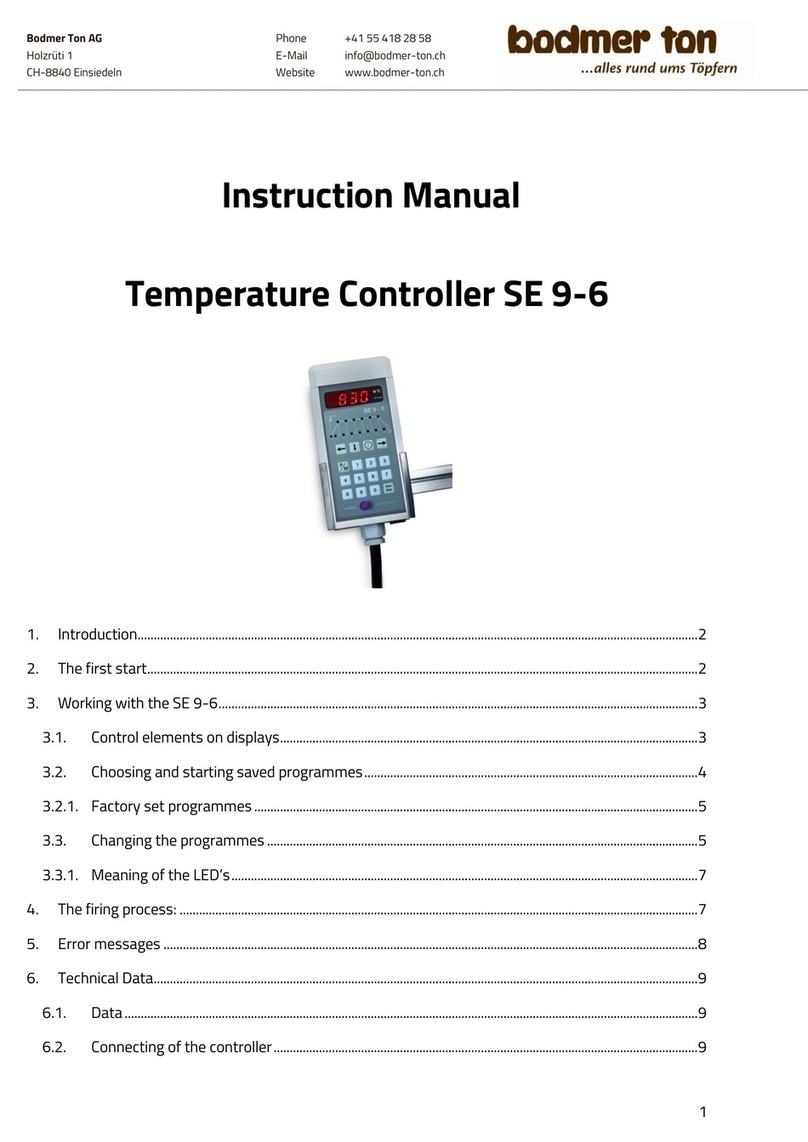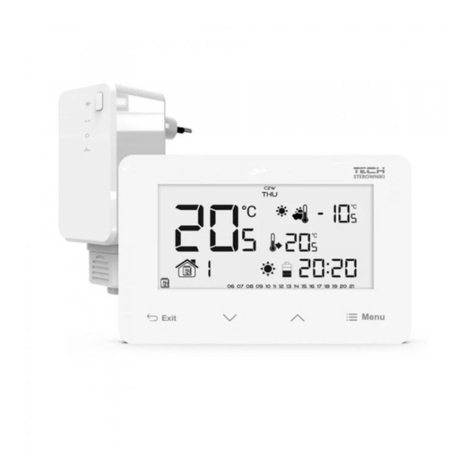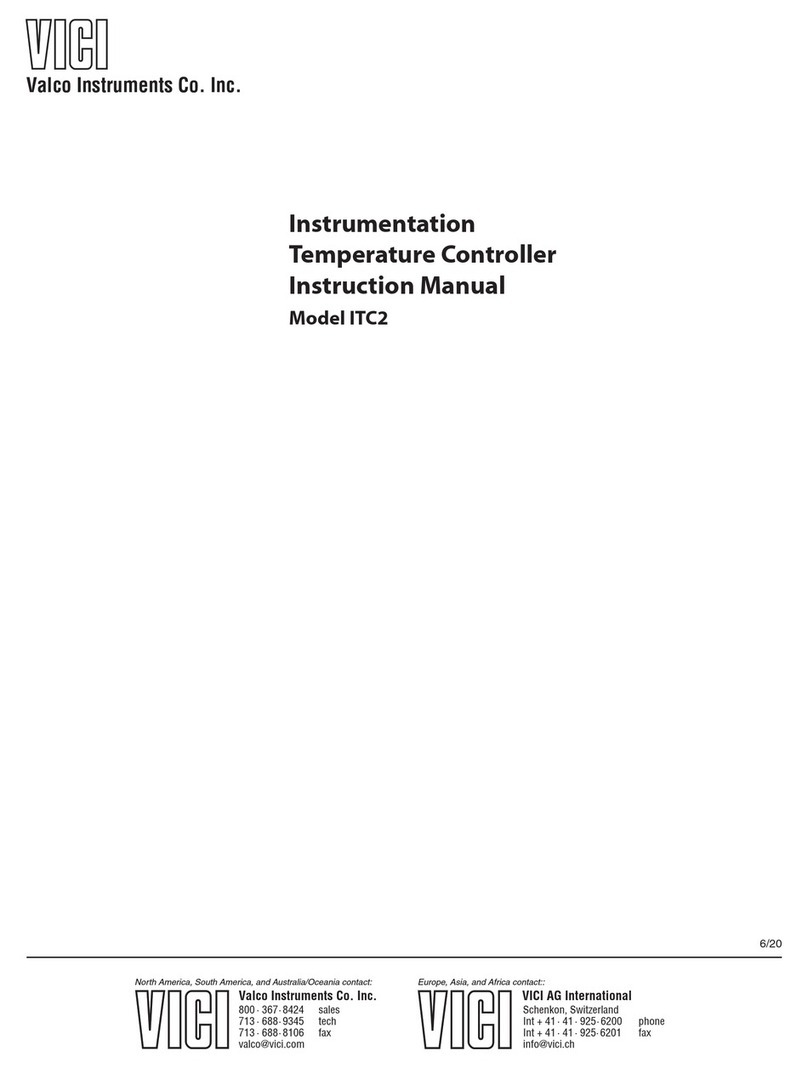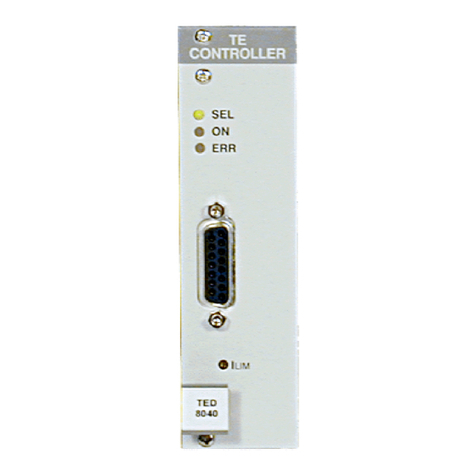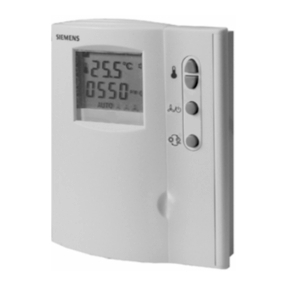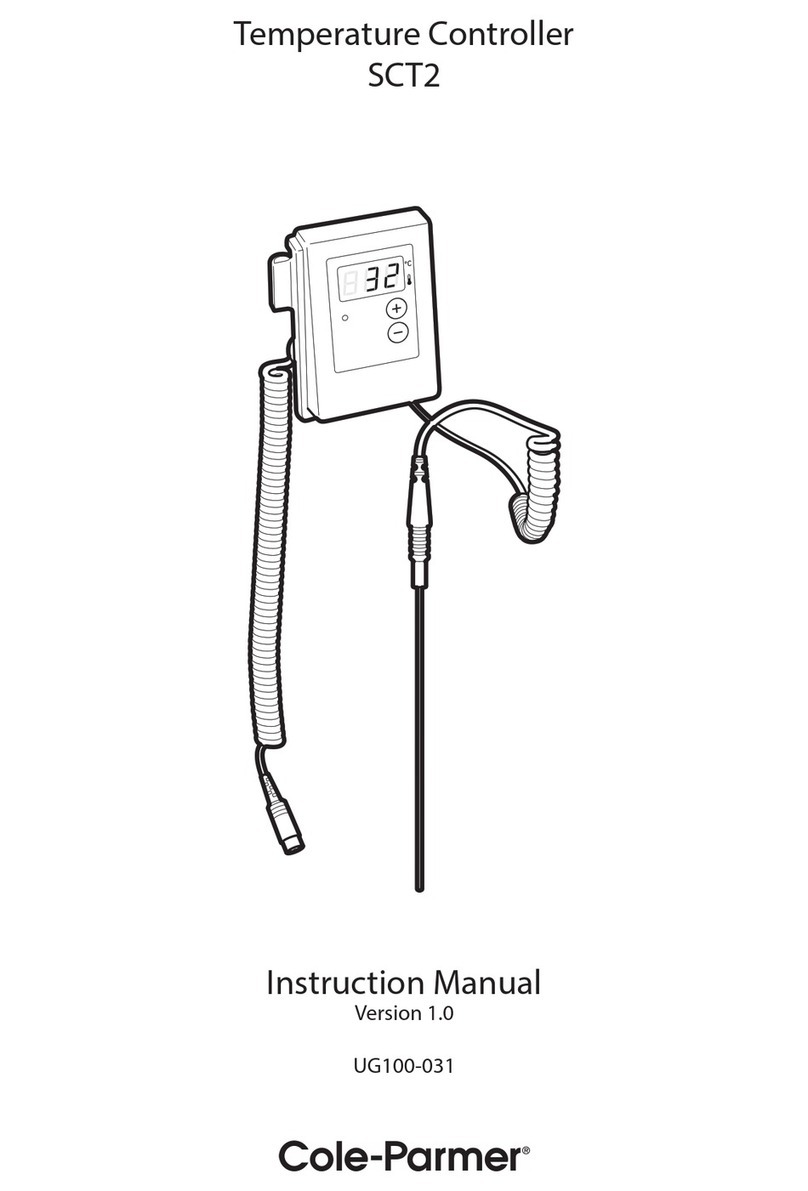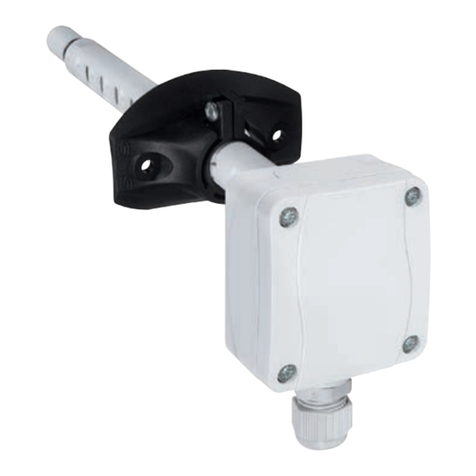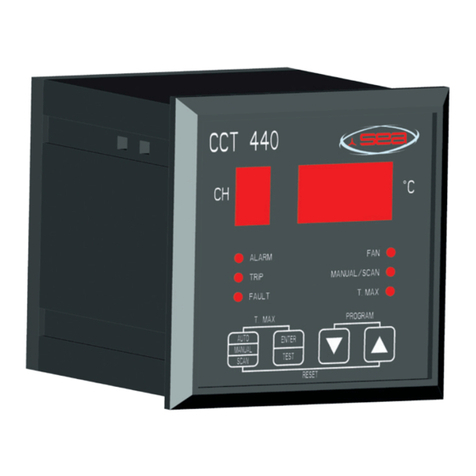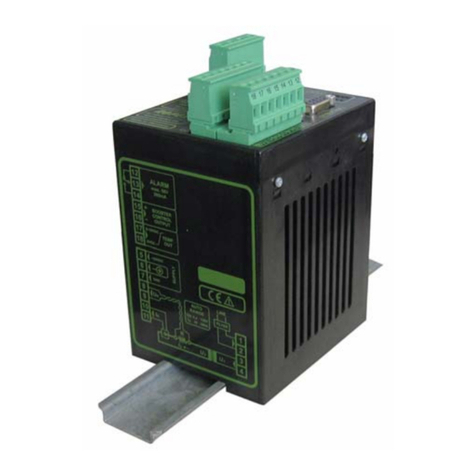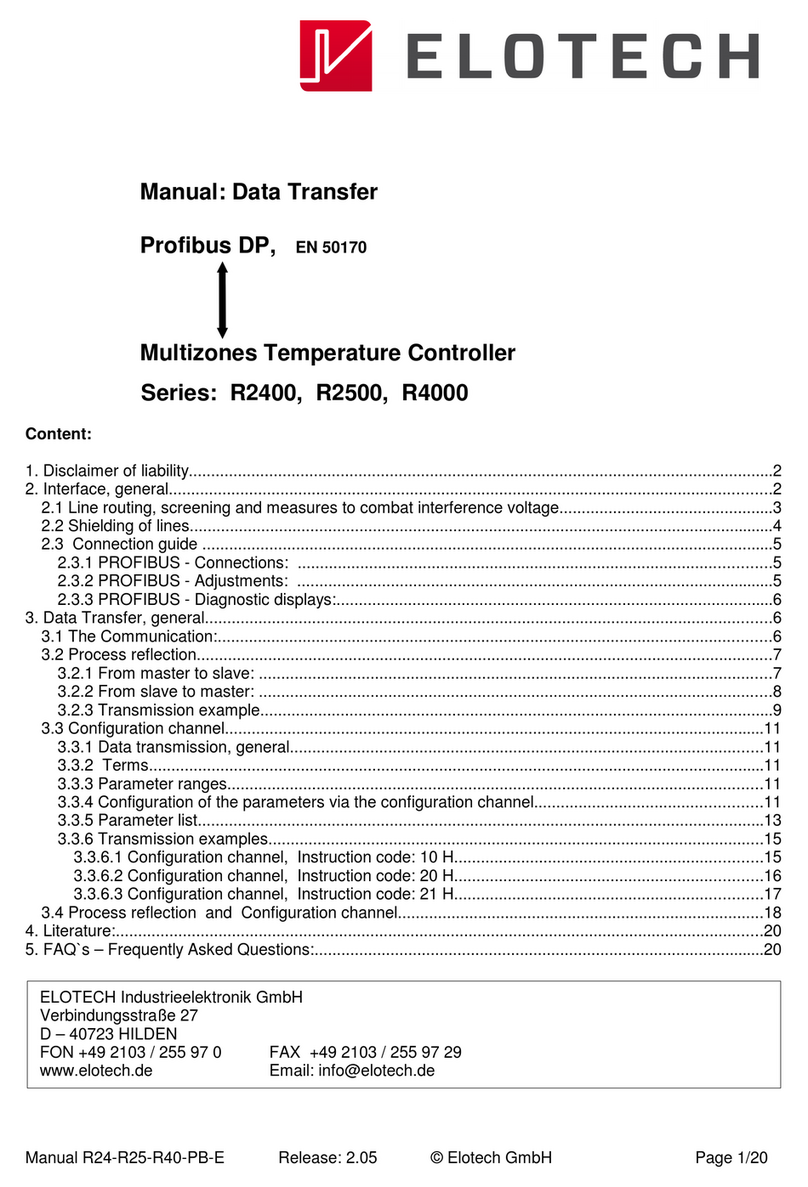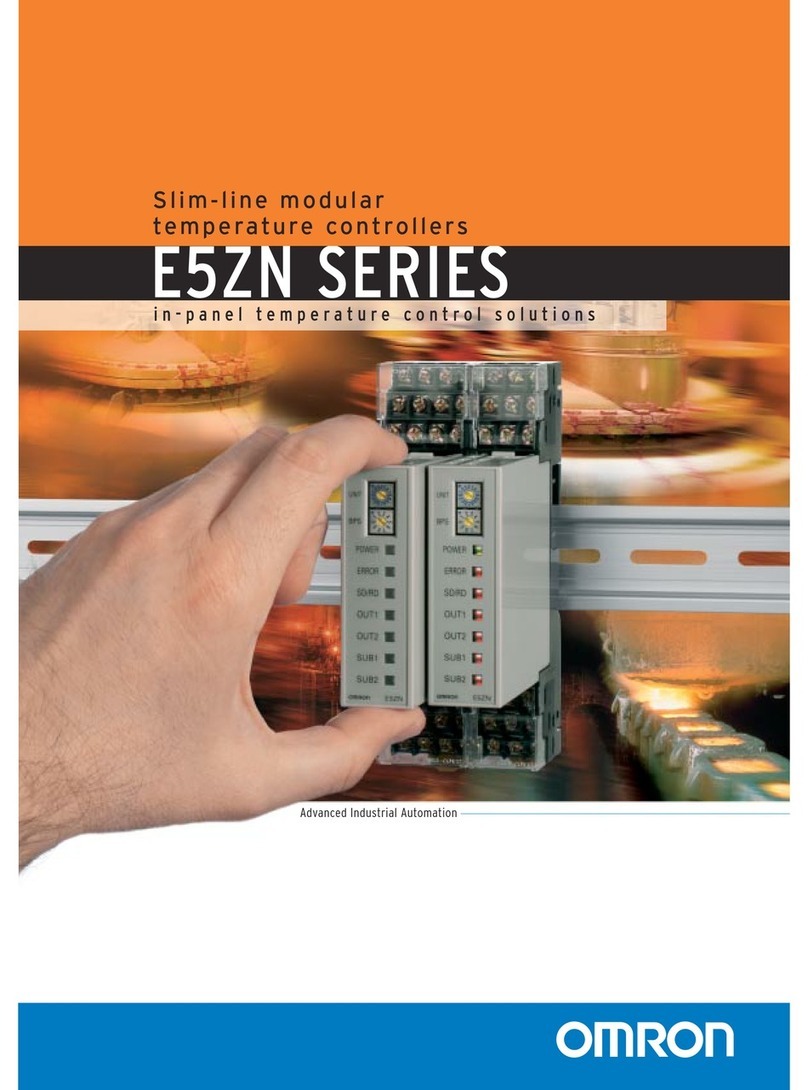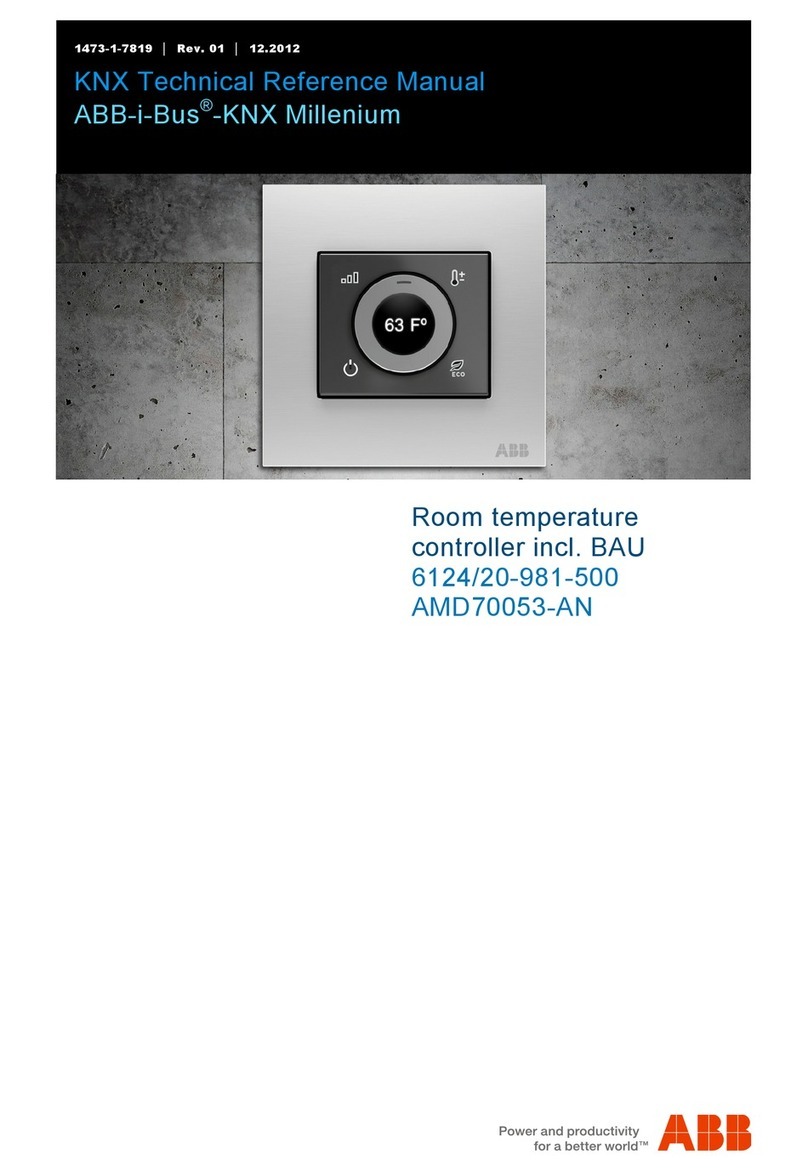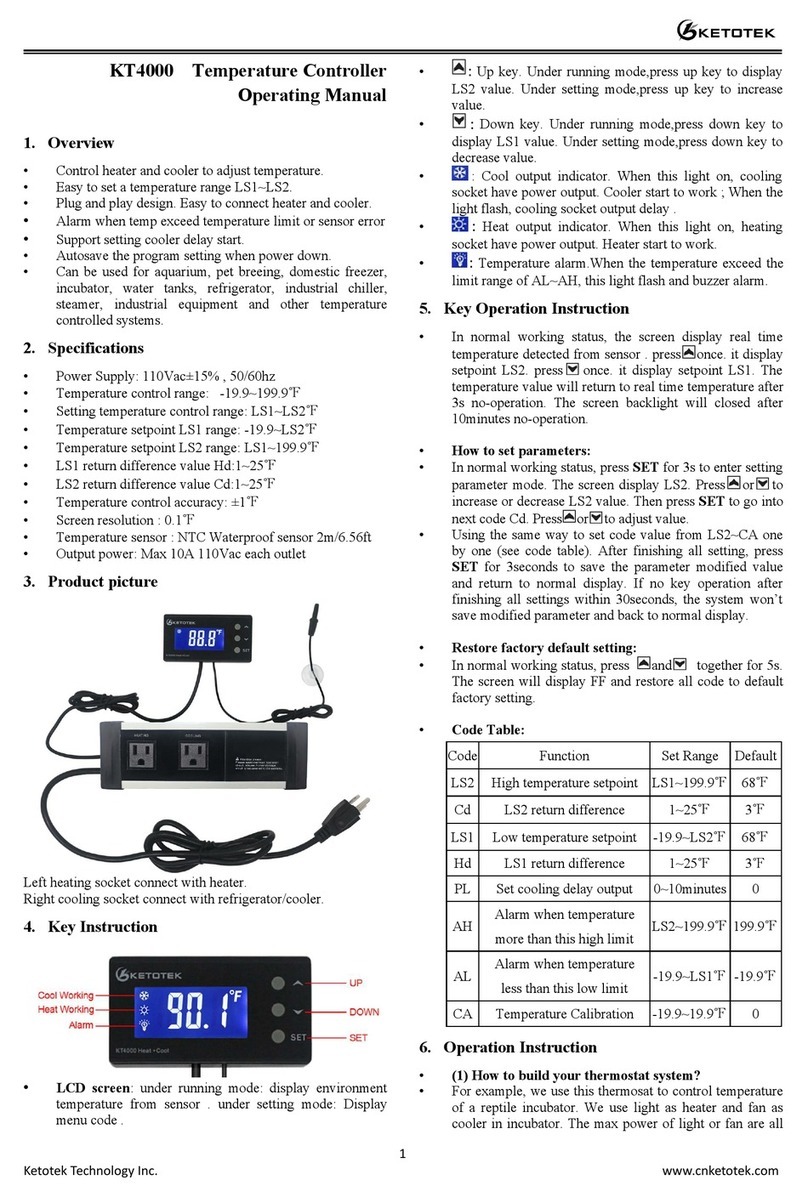Sensor Partners I-Tec Mini Series Manual

I-Tec Mini Series
Operators Guide
Guide de l’opérateur pour la série I-Tec Mini
I-Tec Mini Bedienungsanleitung
Serie I-Tec Mini GuÌa del operario
Serie I-Tec Mini Manuale di istruzione

2
›
english
The I-Tec Mini Series is a range of miniature non-contact infrared temperature sensors
with separate electronics modules.
All models have an adjustable emissivity setting and are capable of measuring a wide
variety of target materials, including food, paper, textiles, plastics, leather, tobacco,
pharmaceuticals, chemicals, ruMBer, coal and asphalt.
The optional touch screen interface provides temperature indication, alarms, sensor
configuration and data logging to MicroSD Card. The optional high-temperature
sensing head may be used in ambient temperatures of up to 180°C without cooling.
The low-noise cable on high ambient temperature models is resistant to interference
from movement, so it is ideal for mounting on moving objects such as robot arms.
A choice of optics are available to measure small or large targets at short or long
distances, and there is a choice of 4-20 mA, RS485 Modbus and alarm relay outputs.
SPECIFICATION
GENERAL
Temperature Range See table of Model Numbers
Maximum Temperature Span (-IT models) 1020°C
Minimum Temperature Span (-IT models) 100°C
Output 4 to 20 mA or RS485 Modbus
Field of View See table of Model Numbers
Accuracy ± 1°C or 1%, whichever is greater
Repeatability ± 0.5°C or 0.5%, whichever is greater
Emissivity Setting Range 0.20 to 1.00
Emissivity Setting Method -I models: via two rotary switches in electronics
module
-MB and -BT models: via RS485
-IT and -BT models: via touch screen
Response Time, t90 240 ms (90% response)
Spectral Range 8 to 14 μm
Supply Voltage 24 V DC ± 5%
Maximum Current Draw 100 mA
Maximum Loop Impedance -I and -IT models: 900 Ω (4 to 20 mA output)
Alarm Relays (-IT models) 2 x Single Pole Changeover alarm relays rated
24 V DC, 1 A, isolated 500 V DC
MECHANICAL
Sensing head Electronics Module
Construction Stainless Steel 316 Die-cast Aluminium
Major Dimensions Ø18 x 45 mm 98(w) x 64(h) x 36(d) mm
Mounting M16 x 1 mm thread Two M4 screws for wall mounting (see
diagram)
Cable Length (sensing head to electronics module) 1 m (standard), up to 30 m (optional)
Weight with 1 m Cable 390 g (approx)
Cable Connections Removable screw terminal blocks (see
Connections). Conductor size: 28 AWG to
18 AWG
Output Cable Gland Suitable for cable diameters 3.0 to 6.5 mm

3
›
english
ENVIRONMENTAL
Sensing Head Electronics Module
(without touch
screen)
Electronics Module
(with touch screen)
Environmental Rating IP65 (NEMA 4) IP65 (NEMA 4) –
Ambient Temperature
Range
See table of Model
Numbers
0°C to 60°C 0°C to 60°C
Relative Humidity Maximum 95%
non-condensing
Maximum 95%
non-condensing
Maximum 95%
non-condensing
CE Marked Yes Yes Yes
RoHS Compliant Yes Yes Yes
ELECTROMAGNETIC COMPATIBILITY STANDARDS:
Class Standard Description
EMC Directive EN61326-1:2006 Electrical equii-Tec Minient for measure-
ment, control and laboratory use – Industrial
- Immunity IEC 61000-4-2 Electrostatic Discharge Immunity
IEC 61000-4-3 Electromagnetic Field Immunity
IEC 61000-4-4 Burst Immunity
IEC 61000-4-5 Surge Immunity
IEC 61000-4-6 Conducted RF Immunity
- Emissions EN 55022A RF Emissions Class A
EN 55022B RF Emissions Class B
MODEL NUMBERS
The following combinations of ambient temperature range, optics, measured temperature range,
output and interface are available on I-Tec Mini sensors:
Series
Sensing Head
Operating
Temperature Range
Field of View
Measurement
Temperature
Range
Output and
Interface
I-Tec Mini
MT
102
115
130
CF
LT
MT
HT
XT
I
CT
IT
MB
MBT
HT 120
HT
XT I
CT
IT
MB
MBT

4
›
english
-20
-LT
-MT
-HT
-XT
-CT
0 100
Fixed (e.g. -MT: 0°C @ 4 mA, 250°C @ 20 mA)
-IT models: 4 to 20 mA output configurable within this range
-MBT and -MB models: Digital output, full temperature range
250 500 1000
MEASUREMENT TEMPERATURE RANGE (°C)
OUTPUT AND INTERFACE
-I 4 to 20 mA output, no touch screen
-IT 4 to 20 mA output and two alarm relay outputs, with touch screen
-MB RS485 Modbus output, no touch screen
-MBT RS485 Modbus output and two alarm relay outputs, with touch screen
Diameter of target
spot measured versus
distance from sensing
head at 90% energy
Distance: Sensor to object (inches)
Distance: Sensor to object (mm)
11.9
45.2
78.6
0.5 1.8
3.1
0 19.7 39.4
0
11.9
0500 1000
Spot Dia.
(inches)
Spot Dia.
(mm)
Spot Dia.
(inches)
Spot Dia.
(mm)
Distance: Sensor to object (inches)
Distance: Sensor to object (mm)
61.9
111.9
0.5
2.4
4.4
048
100 200
D:S 15:1D:S 2:1
-102 -115
Distance: Sensor to object (inches)
Distance: Sensor to object (mm)
11.9
36.9 61.9
0.5
1.5 2.5
0 19.7 39.4
0 500 1000
Spot Dia.
(inches)
Spot Dia.
(mm)
D:S 20:1
-120
Spot Dia.
(inches)
Spot Dia.
(mm)
Distance: Sensor to object (inches)
Distance: Sensor to object (mm)
11.9
0.5
0
0
5.0
0.20
100
3.9
12.5
0.49
200
7.9
-CF5
Distance: Sensor to object (inches)
Distance: Sensor to object (mm)
11.9
28.6 45.2
0.5
1.1 1.8
0 19.7 39.4
0 500 1000
Spot Dia.
(inches)
Spot Dia.
(mm)
D:S 30:1
-130
FIELD OF VIEW
SENSING HEAD OPERATING TEMPERATURE RANGE
-MT 0°C to 60°C
-HT 0°C to 180°C
The high ambient temperature sensing head on -HT models is capable of withstanding temperatures
of up to 180°C without cooling. It is available with 20:1 optics.
There is no need to supply cooling air or water, and the miniature sensing head is much smaller than
bulky, cooled sensors.

5
›
english
EXAMPLE: I-TEC MINI-MT-130-CT-MBT
Series Sensing Head
Operating
Temperature
Optics Temperature
Range
Output and
Interface
I-Tec Mini
I-Tec Mini
-MT 0°C to 60°C -130 30:1
divergent
-CT congurable
within the limits:
-20 to 1000 °C
-MBT RS485 Modbus
output and two alarm
relay outputs, with
touch screen
EMISSIVITY ADJUSTMENT (-I MODELS)
The emissivity setting on I-Tec Mini -I models may be adjusted via two rotary switches inside the
electronics box. To adjust the emissivity setting:
Set the left switch to the first digit after the decimal point (0.1).
Set the right switch to the second digit after the decimal point (0.01).
To enter an emissivity setting of 1.00, set both switches to 0.
The minimum emissivity setting is 0.2. If a lower emissivity setting is selected, the sensor will default
to an emissivity setting of 0.95.
For example:
Left switch Right switch Emissivity setting
6 3 0.63
0 0 1.00
TOUCH SCREEN (-IT AND -MBT MODELS)
The optional backlit touch screen interface mounted in the lid of the electronics module provides a
large, bright display of the measured temperature, as well as options for full configuration of the
sensor. The graph view shows the history of the measured temperature.
In alarm conditions, the display changes colour to provide an immediate and obvious alarm
indication. Alarm modes and levels can be configured via the touch screen.
TOUCH SCREEN SPECIFICATIONS
Touch Screen Display Format 2.83” (72 mm) resistive touch TFT, 320 x 240 pixels, backlit
Congurable Parameters Temperature range, temperature units, emissivity setting,
reected energy compensation, alarms, signal processing,
Modbus address (-MBT models), date and time, data logging
Temperature Units °C or °F congurable
Temperature Resolution 0.1°
Alarm Conguration Two alarms with adjustable level, individually congurable as
HI or LO. Alarm 2 can be set to target temperature or sensing
head internal temperature
Signal Processing Average, peak hold, valley hold, minimum, maximum

6
›
english
USER INTERFACE
Default View Temperature View
Displays a large indication of the measured temperature. The background
turns bright red when an alarm is activated.
Setting
Temperature
Units
Selecting
Displayed
Temperature
Press “°C” to switch to °F and vice versa. The units are changed throughout
the interface.
Press the temperature display to select which reading is shown:
Filtered Temp
The measured temperature, with averaging and hold processing. This
temperature is output by the sensor on the 4 to 20 mA output (-I and -IT
models).
Average Temp
The measured temperature with averaging but without hold processing.
Unltered Temp
The unprocessed measured temperature.
MicroSD Card status.
This icon is displayed when an SD card is inserted, and ashes when data
logging is in progress.
This icon is displayed when scheduled data logging is enabled and has yet
to begin.
List View
Displays a list of the measured temperatures, alarm state and data logging
state.
Filtered Temp: The measured temperature, with averaging and hold
processing.
Unltered Temp: The unprocessed measured temperature.
Average Temp: The Unltered Temperature averaged over the period
specied in “Output Processing”.
Maximum Temp: The highest temperature measured during the hold period,
with averaging.
Minimum Temp: The lowest temperature measured during the hold period,
with averaging.
Sensor Temp: The internal temperature of the sensing head.
Reected Temp: The reected energy compensation temperature, as
specied in “Emissivity and Compensation”.

7
›
english
Lock/Unlock
Prevents settings being changed via a four-digit numerical code.
The default password is 1234.
Change Password
Enter, conrm and save a new four-digit code.
Start/Stop Logging
Manually begins or ends data logging (requires MicroSD Card, available
separately).
If Scheduled Start is enabled in Settings > Data Logging, then logging cannot
be started manually.
To manually start logging, you must rst disable Scheduled Start.
Graph
Displays the recent history of the Filtered Temperature and the Sensor
Temperature. To scroll backwards and forwards in time, touch the graph and
drag it. The graph stores the most recent 24 hours of temperature data.
Reset Graph
Clears and restarts the graph.
Real-Time Scrolling View
Returns the graph to the real-time scrolling view, showing the most recent
measurements.
Acknowledge Alarms
Switches the relay outputs for triggered alarms to their normal, untriggered
state. The background of the Temperature View, List View and Graph View
will stay red, and the alarms will not be triggered again, until the alarms are
reset (see “Alarms” below). Alarms can be acknowledged when the display
is locked.
Settings
Access the conguration parameters. Press Apply to save the settings,
or Exit to leave the screen without saving.

8
›
english
SETTINGS
Date & Time
Change the date and time for data logging purposes. The clock is reset when
the power is cycled unless a battery is tted.
Output Processing
Averaging
Period
Hold Mode
Hold Period
Set the time, in seconds, over which the measured temperature is averaged.
Note: averaging prevents the sensor from following rapid temperature
changes. Minimum: 0 (no averaging). Maximum: 60.
Peak
The sensor holds the maximum temperature steady for the Hold Period.
After this, the sensor responds normally. If the sensor detects a higher
temperature, it holds this temperature steady for the Hold Period.
Valley
Similar to Peak Hold mode except that the sensor outputs the minimum
detected temperature steady for the Hold Period.
Off
Disables hold processing.
Set the time, in seconds, for the sensor to hold the temperature as above.
Minimum: 0 (no hold processing). Maximum: 1200.
Data Logging
Sample
Period
Number of
Samples
Enable
Scheduled
Start
Date and
Time
The time, in seconds, between samples. Minimum: 1. Maximum: 86,400
(1 day).
The number of samples to collect before logging stops. Minimum: 0
(continuous logging). Maximum: 86,400 (1 day of data if Sample Period = 1
second).
The sensor begins logging at the Date and Time specied. Logging can also
be started and stopped manually.
The date and time for scheduled logging to start.

9
›
english
Emissivity and Compensation
Emissivity
Setting
Enable
Reected
Energy
Compensation
Reected
Temperature
Enter the emissivity of the target. Target emissivity can be determined
experimentally, or estimated using an emissivity table. For more information,
contact I-Tec. Minimum: 0.2. Maximum: 1.0.
If enabled, compensates for errors caused by reected energy from hotter or
colder objects.
Enter the temperature of the surroundings of the target for Reected Energy
Compensation. Minimum: -20°C. Maximum: 1000°C.
4 to 20 mA Output (-IT models)
Set the temperature range limits for the 4 to 20 mA output.
Temperature
at 4 mA
Temperature
at 20 mA
Please note
The lower temperature range limit. Minimum: -20°C. Maximum: 900°C.
The upper temperature range limit. Minimum: 80°C. Maximum: 1000°C.
The difference between the temperatures at 4 mA and at 20 mA must be at
least 100°C. The temperature at 20 mA must be greater than the temperature
at 4 mA.
Modbus Address (-MBT models)
Modbus
Address
The current Modbus address of the sensor is displayed. Enter a new address,
then press Apply to save it to the sensor. Cycle the power to use the new
address.
Minimum: 1. Maximum: 247.
Alarms
Congure the settings for Alarm 1 and Alarm 2 separately, and congure
alarm logging settings.
Manually Reset Alarms
If an alarm has been triggered, allows both alarms to be triggered again.
Alarms will not be triggered again until they are reset, either automatically or
manually.
SETTINGS (continued)

10
›
english
Alarm 1 and Alarm 2
Alarm Set
Point
Hysteresis
Filtered
Temperature
or Sensor
Temperature
(Alarm 2 only)
Alarm Type
Reset
The temperature at which the alarm is triggered. Minimum: -20°C. Maximum:
1000°C.
The temperature difference between the Alarm Set Point and the reset
temperature. Hysteresis is only used when Automatic Reset is enabled.
Please see the diagrams below for more information
Minimum: 0°C (hysteresis disabled). Maximum: 1000°C.
Select the temperature monitored by Alarm 2.
High
The alarm is triggered when the temperature rises above the Alarm Set Point.
Low
The alarm is triggered when the temperature drops below the Alarm Set
Point.
Off
The alarm is disabled.
Automatic
The alarm is acknowledged and reset automatically when the temperature
reaches the reset temperature (see Hysteresis). It can also be acknowledged
or reset manually.
Manual
The alarm is acknowledged by pressing Acknowledge on the
Temperature View or List View, and reset by pressing Reset on the
Alarms screen.
Alarm Logging
Alarm events can be logged to the MicroSD Card. Alarm log les and settings
are independent from Data Logging.
Log Trigger
Time
Log Data
While
Triggered
Log
Acknowledge
Time
Log Reset
Time
The time that an alarm is triggered will be logged.
Data logging will start when an alarm is triggered. 1 sample is logged per
second. Logging stops when both alarms are reset.
The time that the alarm is acknowledged will be logged.
The time that the alarm is reset will be logged.
SETTINGS > ALARMS

11
›
english
ALARM OPERATION WITH HYSTERESIS & AUTOMATIC RESET
DATA LOGGING (-IT AND -MBT MODELS)
The I-Tec Mini can be used as a standalone data logger.
I-Tec Mini models -IT and -MBT include a MicroSD card slot for data logging, which can be
congured via the touch screen interface. The user can select the sample rate and the number of
samples to be taken and schedule the data logging to start at a certain time.
With a 2 GB card, the user can store 28.4 million readings, which provides almost 1 year’s worth
of data at the fastest possible sample rate of 1 per second.
Data is stored on the MicroSD card in .csv format and can be viewed and edited easily using
spreadsheet software.
A MicroSD card with SD card adapter is available as an optional accessory.
The MicroSD card slot and battery holder are located on the touch screen circuit board in the
lid of the I-Tec Mini. Readings are time and date stamped using the sensor’s internal clock. The
clock is reset when the power is disconnected, or it will continue if the optional battery is tted.
DATA LOGGING SPECIFICATIONS
Data Logging Interval 1 to 86,400 seconds (1 day)
MicroSD Card Max. capacity: 2 GB (not included)
Internal Clock Battery 1 x BR 1225 3V (not included)
Variables Logged Target temperature, sensing head temperature, electronics module temperature,
max, min, average, emissivity setting, reected energy compensation temperature
File format .csv
Congurable Parameters Sample period, number of samples, scheduled start date and time
Modbus address range 1 to 247
USING THE I-TEC MINI AS A DATA LOGGER
1. Insert a MicroSD card into the holder on the circuit board inside the lid of the I-Tec Mini electronics module.
2. To retain the date and time when the I-Tec Mini is switched off, fit a battery to the holder on the
circuit board inside the lid.
3. Replace the lid and connect the sensor power supply.
4. To set the number of samples to be logged, the time period between samples, and, if required,
to schedule data logging to automatically start, press to access the Settings menu, then
press to access the Data Logging options.
5. To save data logging settings, press
6. To manually start data logging, press on the Temperature View or List View.
7. While logging is in progress, the logging icon flashes on the Temperature View and List View.
8. To stop data logging, press .
9. To transfer data to a computer, remove the MicroSD Card from the sensor, insert the card into
the SD Card adapter (supplied with MicroSD Card, accessory model SPLOG) and insert the
adapter into an SD Card reader.
Note: MicroSDHC Cards are not compatible with the I-Tec Mini.
Alarm triggered Alarm reset
Alarm Set Point
Hysteresis
Temperature
Time Alarm triggered Alarm reset
Alarm Set Point
Hysteresis
Temperature
Time
High Alarm with Automatic Reset Low Alarm with Automatic Reset

12
›
english
DATA LOG FILES
Data is saved to the MicroSD Card in .csv format. This file format can be opened or imported by
spreadsheet software such as Microsoft Excel.
A new folder is created on the MicroSD Card for each day that data is logged.
A new log file is created every time logging is started. The start time is used as the file name.
Thread M16 x 1 mm
Standard length:
18
98
48
18
64
36
20
36
86
1000 45
13
12
ø 18.6
Air Purge Collar
Sensing Head
4
18
ø 40 ø 29
25
1/8" BSP
air fitting
Removable spigot fitted to
type APSN for use with
-151, -201, -301 and -CF
models. Not fitted to type
APSW for -21 models.
Mounting Nut
(included)
ø 18
50
Electronics Module
Touch screen
(optional)
72 mm (2.83")
Cable glands:
14 mm AF
Mounting
holes: use M4
CSK screws
(supplied)
DIMENSIONS
MicroSD Card
Battery
(use 1 x BR 1225 3V)
INSTALLATION OF MICROSD CARD AND BATTERY

13
›
english
10
40
50 50
40
9
15
25 25
60° Rotation 60° Rotation
60° Rotation
9
48
Fixed Mounting Bracket (FBS)Adjustable Mounting Bracket (ABS)
2 x Mounting Holes M4 Clearance2x Mounting Holes M4 Clearance
9
2424
M16 Clearance
ACCESSORIES
A range of accessories to suit different applications and industrial environments is available. These
may be ordered at any time and added on-site. The following accessories are available from I-Tec:
Fixed mounting bracket (see above for dimensions): Allows rotational adjustment in one
dimension. Model number: FBS.
Adjustable mounting bracket (see above for dimensions): Allows rotational adjustment in two
dimensions. Model number: ABS.
Air purge collar (see above for dimensions): The air purge collar is used to keep dust, fumes,
moisture, and other contaminants away from the lens. It must be screwed fully onto the
sensing head. Air flows into the 1/8” BSP fitting and out of the front aperture. Air flow should
be 5 to 15 l/min. Clean or ‘instrument’ air is recommended. Model APSW is for use with
sensors with 2:1 optics. Model APSN is for use with all other I-Tec Mini models.
Laser sighting tool: When fitted to the sensor during installation or re-alignment, the laser
sighting tool pinpoints the centre of the measured spot. Model number: LSTS.
MicroSD Card: Stores logged data. For use with -MBT and -IT models. Includes SD Card
adapter. Model number: SPLOG.
OPTIONS
The following options are available. Options are factory installed and must be ordered with the
sensor.
Calibration Certificate: UKAS traceable certificate showing the measured temperature at
three points across the sensor’s temperature range. Model number: CALCERTA.
Extended Cable (30 m maximum total cable length): 1 m cable is supplied with each sensor
as standard. Extra cable can be added to this in increments of 1 m. Model number: VKVL
(-MA models), VKVLHT (-HA models).

14
›
english
INSTALLATION
The installation process consists of the following stages:
Preparation Mechanical installation Electrical installation
Please read the following sections thoroughly before proceeding with the installation.
PREPARATION
Ensure that the sensor is positioned so that it is focused on the target only.
DISTANCE AND SPOT SIZE
The size of the area (spot size) to be measured determines the distance between the sensor and
the target. The spot size must not be larger than the target. The sensor should be mounted so
that the measured spot size is smaller than the target.
AMBIENT TEMPERATURE
The I-Tec Mini is available with a choice of two miniature sensing heads, for use in low or high
ambient temperatures:
-MA models: The sensing head is designed to operate in ambient temperatures from 0°C to 60°C.
-HA models: The sensing head is designed to operate in ambient temperatures from 0°C to
180°C. No cooling is required, which saves the energy and cost of supplying air or water to
cool the sensor.
Avoid thermal shock. Allow 20 minutes for the unit to adjust to large changes in ambient
temperature.
ATMOSPHERIC QUALITY
Smoke, fumes, dust or steam can contaminate the lens and cause errors in temperature
measurement. In these types of environment the air purge collar should be used to help keep the
lens clean.
INTERFERENCE FROM MOVEMENT
The low-noise sensing head cable on -HA models is resistant to interference caused by movement.
The sensing head may be mounted on moving machinery such as robot arms without affecting the
accuracy of the measured temperature.
ELECTRICAL INTERFERENCE
The I-Tec Mini is tested to industrial standards for electromagnetic compatibility (EMC) as shown in
Specifications at the beginning of this manual.

15
›
english
To minimise electromagnetic interference or ‘noise’, the sensor should be mounted away from
motors, generators and such like.
POWER SUPPLY
Be sure to use a 24 V DC (100 mA) power supply.
MECHANICAL INSTALLATION
All sensors come with a 1 m cable and a mounting nut as standard. Longer cables are available to
order. The sensor can be mounted on brackets or cut-outs of your own design, or you can use the
fixed or adjustable mounting bracket accessories.
Note: The sensor housing must be connected to earth at one point, either the housing of the
sensing head, the electronics module, or the output cable shield termination. To avoid ground
loops, please ensure the sensor is grounded at only one of these points.
ELECTRICAL INSTALLATION
CONNECTIONS
Sensing Head Cable
Colour Codes (all models):
TP+ Blue with white line
TP- White with blue line
TH+ Blue
GND White
PWR+
PWR+
OP-
OP-
PWR-
PWR-
PWR-
OP+
OP+

16
›
english
WIRING (ALL MODELS)
Check the distance between the sensing head and the electronics module, and between the
electronics module and the instrumentation. If necessary, the sensor can be ordered with a longer
cable between the sensing head and the electronics module.
The output cable from the electronics module should have an outer diameter between 3.0 and 6.5
mm, with conductors of size 28 to 18 AWG.
The terminal blocks in the electronics module may be removed from the circuit board for easy
wiring.
Do not disconnect the touch screen circuit board from the main circuit board while the sensor is on.
WIRING (-MB AND -MBT MODELS)
When connecting several sensors in a single Modbus network, all of the sensors should be
connected via a junction box to a single network bus cable, running from the furthest sensor to the
Modbus Master.
Up to 247 sensors may be connected to a single Modbus network. Each sensor must have a
unique Modbus address. I-Tec Mini sensors are normally shipped with Modbus address 1. The
Modbus address may be changed via the touch screen interface on -MBT models, or via Modbus.
To help prevent data reflections, please ensure the cable between each sensor and the main
network bus is as short as possible. The network bus should be terminated with a resistor of 120Ω
between the RS+ and RS- wires. The PWR- wire of the bus should be connected to the signal
ground of the Modbus Master.
MODBUS OVER SERIAL LINE (RS485)
Interface
Baud rate 9600
Format 8 data, No parity, 1 stop bit
Reply delay (ms) 20
Supported functions
Read register 0x03, 0x04
Write single register 0x06
Write multiple register 0x10
Mask write register 0x16
Read/write 0x17
The list below includes all available addresses:
R = Read
W = Write (single, multiple or read/write)
MW = Mask write
Address Length
(words)
Description R/W/MW
0x00 1 MODBUS slave address R/W*
0x02
2
Sensor identification register
Bits 0..19 - Serial number
Bits 20..23 - Sensor type (12 = I-Tec Mini)
Bits 24..26 - Sensor field-of-view
For MA : 0 = 2:1, 1 = 15:1, 2 = 30:1
For HA : 0 = 20:1
Bits 28..32 - Reserved
R

17
›
english
Address Length
(words)
Description R/W/MW
0x06 1 Unfiltered object temperature R
0x08 1 Sensor temperature R
0x0A 1 Maximum temperature over hold period R
0x0C 1 Minimum temperature over hold period R
0x0E 1 Average temperature over hold period R
0x10 1 Filtered object temperature R
0x12 1 PI temperature R
0x14
1
Emissivity (1 LSB = 0.0001)
Minimum 0.2000, Maximum 1.0000
R/W
0x16 1 Reflected temperature R/W
0x18
1
Sensor status register
Bits 0..1 - Reserved
Bit 2 - Hold processing on (1)/off (0)
Bit 3 - Hold peaks (1)/valleys (0)
Bits 4..6 - Reserved
Bit 7 - Reflected energy compensation on (1)/
off (0)
Bits 8..15 - Reserved
R/W/MW
0x1A
1
Average period (1 LSB = 0.05 seconds)
Minimum 0.05 seconds, Maximum 60.00
seconds
R/W
0x1C
1
Hold period (1 LSB = 0.05 seconds)
Minimum 0.05 seconds, Maximum 1200.00
seconds
R/W
0x1E 1 Temperature at 4 mA
Minimum -20°C, Maximum 900°C
R/W
0x20 1 Temperature at 20 mA
Minimum 80°C, Maximum 1000°C
R/W
0x22 1 Alarm 1 setpoint
Minimum -20°C, Maximum 1000°C
R/W
0x24 1 Alarm 1 hysteresis
Minimum 0°C, Maximum 1000°C
R/W
0x26 1 Alarm 1 status register
Bit 0 – Relay triggered (R)
Bit 1 – Visible alarm active (R)
Bit 2 – Alarm triggered (R)
Bit 3 – Auto reset (1)/manual reset (0) (R/W/
MW)
Bit 4 – Alarm acknowledge (R/W/MW)
Bit 5 – Alarm reset (R/W/MW)
Bits 6..7 – Reserved
Bit 8 – High alarm (1)/low alarm (0) (R/W/MW)
Bit 9 – Alarm enabled (1)/disabled (0)
Bits 10..15 – Reserved
R/W/MW

18
›
english
Address Length
(words)
Description R/W/MW
0x28 1 Alarm 2 status register
Bit 0 – Relay triggered (R)
Bit 1 – Visible alarm active (R)
Bit 2 – Alarm triggered (R)
Bit 3 – Auto reset (1)/manual reset (0) (R/W/
MW)
Bit 4 – Alarm acknowledge (R/W/MW)
Bit 5 – Alarm reset (R/W/MW)
Bit 6 – Reserved
Bit 7 – Filtered object temperature (1)/head
temperature (0) (R/W/MW)
Bit 8 – High alarm (1)/low alarm (0) (R/W/MW)
Bit 9 – Alarm enabled (1)/disabled (0)
Bits 10..15 – Reserved
R/W/MW
0x2A 1 Alarm 2 setpoint
Minimum -20°C, Maximum 1000°C
R/W
0x2C 1 Alarm 2 hysteresis
Minimum 0°C, Maximum 1000°C
R/W
* Single register writes only. New address will not take effect until next power on.
Notes:
1. All temperatures are in tenths of degrees C
2. Writing to unlisted registers could cause malfunction
3. All write and mask operations are saved to non-volatile memory
4. For further information please refer to http://www.modbus.org/specs.php
5. Use address 255 to communicate with any connected sensor. Use address 0 to broadcast to
all connected sensors (no response expected)
OPERATION
Once the sensor is in position and the appropriate power, air and cable connections are secure,
the system is ready for continuous operation by completing the following simple steps:
1. Turn on the sensor power supply
2. Turn on the connected instrumentation
3. Read, monitor or log the temperature
IMPORTANT
Be aware of the following when using the sensor:
• If the sensor is exposed to significant changes in ambient temperature (hot to cold, or cold to
hot), allow 20 minutes for the temperature to stabilise before taking or recording measurements.
• Do not operate the sensor near large electromagnetic fields (e.g. around arc welders or induction
heaters). Electromagnetic interference can cause measurement errors.
• Wires must be connected only to the appropriate terminals.
VIEWING THROUGH A WINDOW
The I-Tec Mini is capable of measuring the temperature of a target through a window made of a
material that is transmissive to infrared radiation at 8-14 microns. The emissivity setting of the
sensor should be adjusted to compensate for the presence of the window. Please contact I-Tec for
more information on using the I-Tec Mini with a window.

19
›
english
MAINTENANCE
Our customer service representatives are available for application assistance, calibration, repair, and
solutions to specific problems. Contact our Service Department before returning any equii-Tec Minient.
In many cases, problems can be solved over the telephone. If the sensor is not performing as it should,
try to match the symptom below to the problem. If the table does not help, call I-Tec for further advice.
Troubleshooting
Symptom Probable Cause Solution
No output No power to sensor Check power supply
Erroneous temperature Incorrect wire connection Check wire colour codes
Erroneous temperature Faulty sensor cable Verify cable continuity
Erroneous temperature Field of view obstruction Remove obstruction
LENS CLEANING
Keep the lens clean at all times. Any foreign matter on the lens would affect measurement accuracy.
Blow off loose particles (if not using the air purge accessory) with an air ‘puffer’.
GUARANTEE
I-Tec guarantees each instrument it manufactures to be free from defect in material and workmanship
under normal use and service for the period of two years from the date of purchase. This guarantee
extends only to the original buyer according to I-Tec terms and conditions of Sale.

20
›
français
La série I-Tec Mini est une gamme de mini-capteurs de température infrarouge avec
électronique séparée.
Tous les modèles disposent d’un réglage d’émissivité et sont capables de mesurer une
grande variété de matériaux : nourriture, papier, textiles, plastiques, cuir, tabac,
produits pharmaceutiques, produits chimiques, caoutchouc, charbon et l’asphalte.
L’option écran tactile permet l’indication de température, les alarmes, la configuration
du capteur et l’enregistrement des données sur carte MicroSD. L’option tête de
détection haute température permet une utilisation à des températures ambiantes
allant jusqu’à 180 ° C sans refroidissement. Sur les modèles haute température, les
câbles supportent les déplacements pour des montages sur bras robot.
Un large choix d’optiques est disponible pour s’adapter aux tailles des cibles et aux
distances demesures. Les modèles dispose de sorties 4-20 mA, alarmes et RS 485
MODBUS.
SPÉCIFICATIONS
GÉNÉRALES
Plage de températures Voir table des références
Etendue Maximum Temperature (-IT models) 1020°C
Etendue Minimum Temperature (-IT models) 100°C
Sorties 4-20 mA / RS485 Modbus
Champ de vision Voir table des références
Précision ± 1% de la mesure ou ± 1°C, celui qui est le
plus important
Fidélité ± 0,5% de la mesure ou ± 0,5°C, celui qui est
le plus important
Plage de réglage d’émissivité 0.20 – 1.00
Méthode de réglage d’émissivité Modèle -I : 2 commutateurs rotatifs sur carte
électronique
Modèles -MB et -BT : via RS485
Modèles -IT et -BT : via l’écran tactile
Temps de réponse, t90 240ms (réponse 90%)
Réponse spectrale 8 à 14μm
Voltage d’alimentation 24 V DC ± 5%
Courant d’appel Maximum 100 mA
Impédance en boucle maximale Modèles -I et -IT: 900 Ω (4-20 mA sortie)
Alarmes relais (Modèle -IT) 2 x relais simple inverseur 24 V DC, 1 A, isola-
tion 500 V DC
MECANIQUE
TETE MODULE ELECTRONIQUE
MATIERE INOX 316 Aluminium moulé sous pression
Dimensions Ø18 x 45 mm 98(L) x 64(H) x 36(P) mm
Montage M16 x 1 mm 2 vis M4 pour montage mural (voir schéma)
Table of contents
Languages:
